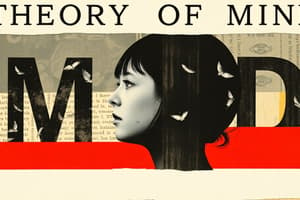Podcast
Questions and Answers
What is the age range when joint attention typically emerges?
What is the age range when joint attention typically emerges?
- 6-9 months old
- 12-15 months old
- 9-12 months old (correct)
- 15-18 months old
What did the study using the violation of expectation paradigm with 6-month-olds reveal?
What did the study using the violation of expectation paradigm with 6-month-olds reveal?
- Infants looked longer when the hand reached for the doll, indicating understanding of intentions (correct)
- Infants were not able to distinguish between the hand reaching for the doll and the hand reaching for the ball
- Infants showed no difference in looking time between the hand reaching for the doll and the hand reaching for the ball
- Infants looked longer when the hand reached for the ball, indicating understanding of intentions
What is a critical indicator of autism spectrum disorders in early development?
What is a critical indicator of autism spectrum disorders in early development?
- Ability to imitate others' actions
- Difficulty with joint attention (correct)
- Early emergence of understanding intentions
- Preference for intentional actions over accidental actions
When does the ability to voluntarily match another person's behavior typically emerge?
When does the ability to voluntarily match another person's behavior typically emerge?
What is the most crucial for teaching to happen between a caregiver and a child?
What is the most crucial for teaching to happen between a caregiver and a child?
What did the study using the violation of expectation paradigm reveal when the position of the ball and the doll were reversed?
What did the study using the violation of expectation paradigm reveal when the position of the ball and the doll were reversed?
What is the understanding of others' intentions crucial for in early development?
What is the understanding of others' intentions crucial for in early development?
At what age do infants begin to understand others' intentions, leading to joint attention and imitation?
At what age do infants begin to understand others' intentions, leading to joint attention and imitation?
What does the rouge test determine in infants?
What does the rouge test determine in infants?
At what age do 12-month-olds understand that desires are linked to actions, unlike 8-month-olds?
At what age do 12-month-olds understand that desires are linked to actions, unlike 8-month-olds?
What is crucial for observational learning and active interpretation of actions?
What is crucial for observational learning and active interpretation of actions?
What is the ability to attribute mental states to oneself and others called?
What is the ability to attribute mental states to oneself and others called?
What enables better understanding of others' unique desires in infants?
What enables better understanding of others' unique desires in infants?
At what age can 3-year-olds predict a character's actions based on the character's desires?
At what age can 3-year-olds predict a character's actions based on the character's desires?
What is the correlation between caregiver's use of mental state talk and preschoolers' theory of mind ability?
What is the correlation between caregiver's use of mental state talk and preschoolers' theory of mind ability?
What type of cognitive processes are involved in executive functioning?
What type of cognitive processes are involved in executive functioning?
What is the implication of individual differences in executive functioning for theory of mind?
What is the implication of individual differences in executive functioning for theory of mind?
What are the implications of social interactions on the development of theory of mind?
What are the implications of social interactions on the development of theory of mind?
What is the primary factor responsible for children's improved theory of mind ability?
What is the primary factor responsible for children's improved theory of mind ability?
At what age does basic theory of mind typically develop?
At what age does basic theory of mind typically develop?
What type of learning is more likely for 3-year-olds according to the text?
What type of learning is more likely for 3-year-olds according to the text?
What enables learning from others through joint attention and imitation?
What enables learning from others through joint attention and imitation?
What is the primary factor responsible for the development of theory of mind?
What is the primary factor responsible for the development of theory of mind?
At what age do children begin to exhibit rudimentary understanding that beliefs lead to actions?
At what age do children begin to exhibit rudimentary understanding that beliefs lead to actions?
What is the 'smarties task' used to demonstrate?
What is the 'smarties task' used to demonstrate?
What does the nativist explanation posit about the development of theory of mind?
What does the nativist explanation posit about the development of theory of mind?
Which brain area is implicated in theory of mind?
Which brain area is implicated in theory of mind?
What is the age at which children understand others' action intentions, according to the social cognition development timeline?
What is the age at which children understand others' action intentions, according to the social cognition development timeline?
What does the stability of social cognition skills suggest?
What does the stability of social cognition skills suggest?
What is the role of the temporoparietal junction (TPJ) in theory of mind?
What is the role of the temporoparietal junction (TPJ) in theory of mind?
Flashcards are hidden until you start studying
Study Notes
Development of Theory of Mind in Children
- Children aged 2 and older begin to understand that others may have different preferences and desires, as demonstrated by their ability to comprehend that someone else may prefer to play with a truck instead of dolls.
- 3-year-olds can discern what people know and what they don't know, as evidenced by a study where they were more likely to learn new words from an adult who previously labeled familiar objects correctly.
- 3-year-olds display an emerging understanding of expertise, selectively seeking specific knowledge from individuals they perceive as experts in certain areas.
- At around 3-4 years old, children begin to exhibit rudimentary understanding that beliefs lead to actions, but they struggle with false-belief problems, indicating a limited understanding of others' beliefs.
- The "smarties task" demonstrates that while 3-year-olds fail to understand that others can have beliefs contrary to their own knowledge, 5-year-olds pass, indicating a developed theory of mind.
- The social cognition development timeline shows that children at 6 months understand others' action intentions, while at 3 years, they are sensitive to others' knowledge and have a basic understanding that beliefs lead to actions.
- Stability of social cognition skills is observed, with children who better understand goal-directed action at 6 months displaying better performance on false-belief tasks at 4 years old.
- The nativist explanation posits that theory of mind is an innate brain mechanism that matures over the first 5 years of life, with evidence from newborns' inherent interest in faces and a culturally universal developmental trajectory of theory of mind.
- The temporoparietal junction (TPJ) is implicated in theory of mind, with evidence from its consistent activity across different theory of mind tasks and the struggles of children with Autism Spectrum Disorder (ASD) in theory of mind, linked to atypical sizes and activity in the TPJ.
- The development of theory of mind is explained by the nativist view, improvements in executive functioning, and the involvement of different brain areas in complex cognitive processes, with the TPJ potentially being the site of the theory of mind module specialized for social processing.
Studying That Suits You
Use AI to generate personalized quizzes and flashcards to suit your learning preferences.




